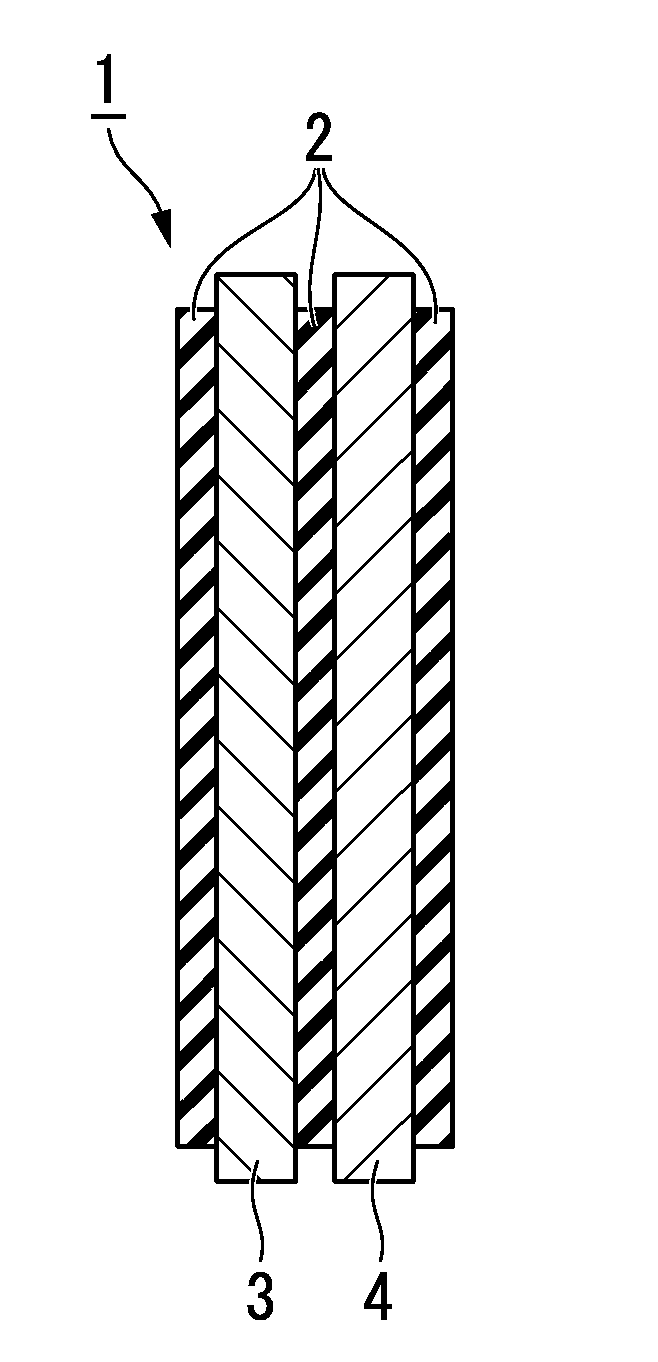Electrical insulation layer and battery device
a battery device and electric insulation technology, applied in the field of electric insulation layer and battery device, can solve the problems of unsatisfactory ion conductivity at room temperature, shrinkage of separator at high temperature, generation of electric short circuit, etc., and achieve excellent electrical insulation excellent battery properties, excellent ion conductivity
- Summary
- Abstract
- Description
- Claims
- Application Information
AI Technical Summary
Benefits of technology
Problems solved by technology
Method used
Image
Examples
example 1-1
Production of Electrical Insulation Layer
[0173]20 g of the polymethylurea was dispersed in 80 g of a deionized water while applying a medium shear force, thereby obtaining a slurry. In the slurry, microparticles (average particle diameter: about 3.5 μm to 6.5 μm) composed of polymethylurea agglomerated were dispersed. Hereafter, these microparticles are sometimes referred to as PMU microparticles.
[0174]4 g of polyvinylalcohl (manufactured by Sigma-Aldrich, average molecular weight: 146,000 to 186,000, 87 to 89% hydrolysis) was dissolved in the deionized water in advance, thereby preparing a 10 wt % aqueous solution. Then, the polymethylurea slurry and the polyvinyl alcohol aqueous solution were mixed together, followed by stirring mildly with a magnetic stirrer for 10 minutes. The operation heretofor was conducted at 25° C.
[0175]Using a No. 50 Meyer Rod, the above obtained mixture (electrical insulation layer composition) was coated on a copper foil with a thickness of 25 μm. Then, ...
example 1-2
Production of Electrolyte
[0181]17 g of the polymethylurea was dispersed in 68 g of a deionized water while applying a medium shear force e, thereby obtaining a slurry. In the slurry, the PMU microparticles are dispersed.
[0182]4 g of polyvinylalcohl (manufactured by Sigma-Aldrich, average molecular weight: 146,000 to 186,000, 87 to 89% hydrolysis) was dissolved in the deionized water in advance, thereby preparing a 10 wt % aqueous solution.
[0183]Subsequently, the polymethylurea slurry was mixed with 10 g of an aqueous solution in which silica gel particles (“Sylojet 30A” manufactured by Grace Davison; silica average particle diameter: 0.3 μm; pore volume: 0.72 ml / g; silica surface area: 171 m2 / g; porosity: 61.3 vol %; internal pore size: 20 nm to 50 nm) as nanoparticles were dispersed with a concentration of 30 wt %. Further, the above polyvinyl alcohol aqueous solution was added thereto, followed by stirring mildly with a magnetic stirrer for 10 minutes. The operation heretofor was ...
example 1-20
[Example 1-3] to [Example 1-20]
[Comparative Example 1-1] to [Comparative Example 1-4]
[0187]An electric insulation layer and an electrolyte in which microparticles and nanoparticles were blended with a weight ratio shown in the table below were produced in the same manner as in [Example 1-1] or [Example 1-2]. The evaluation of the mechanical strength of the electrical insulation layer, the analysis of the porosity and the pore distribution and the measurement of the ion conductivity of the obtained electrolyte were conducted in the same manner as in Example 1-1. The results are shown in the table below.
TABLE 1MicroparticlesNanoparticlesBinder solutionsTotal of(weight ratio)(weight ratio)(weight ratio)weight ratioExample 1-1PMU M6—PVA aqueous solution120(100)(0)(20)Example 1-2PMU M6SiO2 A30PVA aqueous solution120(85)(15)(20)Example 1-3PMU M6SiO2 A30PVA aqueous solution120(70)(30)(20)Example 1-4PMU M6SiO2 A30PVA aqueous solution120(55)(45)(20)Example 1-5PMU M6SiO2 A30PVA aqueous soluti...
PUM
| Property | Measurement | Unit |
|---|---|---|
| electrical insulation | aaaaa | aaaaa |
| total volume | aaaaa | aaaaa |
| structure | aaaaa | aaaaa |
Abstract
Description
Claims
Application Information
 Login to View More
Login to View More - R&D
- Intellectual Property
- Life Sciences
- Materials
- Tech Scout
- Unparalleled Data Quality
- Higher Quality Content
- 60% Fewer Hallucinations
Browse by: Latest US Patents, China's latest patents, Technical Efficacy Thesaurus, Application Domain, Technology Topic, Popular Technical Reports.
© 2025 PatSnap. All rights reserved.Legal|Privacy policy|Modern Slavery Act Transparency Statement|Sitemap|About US| Contact US: help@patsnap.com



